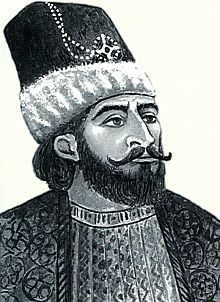قاراباغ خانلیغی
Karabakh Khanate | |||||||||||
|---|---|---|---|---|---|---|---|---|---|---|---|
| 1748–1822 | |||||||||||
 Map of Karabakh Khanate according to a 1902 Russian map. | |||||||||||
| وضعیت | Khanate Under ایرانian suzerainty[۱] | ||||||||||
| پایتخت | |||||||||||
| عۆموُمی دیللر | فارس دیلی (official),[۲][۳] تورکجه ارمنی دیلی | ||||||||||
| تاریخی دؤنم | |||||||||||
• یارادیلدی | 1748 | ||||||||||
• ییخیلدی | 1822 | ||||||||||
| |||||||||||


قاراباغ خانلیغی ۱۷۴۷-جی ایلده نادیرشاه افشارین اؤلوموندن سونرا جاوانشیر سولالهسیندن اولان پناههلی خان قاراباغ خانلیغینین اساسینی قویموشدور. قاراباغ خانلیغی کیچیک قافقاز داغلارینین جنوب-شرقینده یئرلشیردی. خانلیغین سرحدلری آراز چاییندان گؤیچه گؤلوندک، ترتر چاییندان بوتون دوزهنلیک و داغلیق قاراباغی، زنگزورو، برگوشادی احاطه ائتمکله مئهری، تاتئو و سیسیانا قدر اۇزانیردی. خانلیق شکی، گنجه، ایروان، ناخچیوان، قاراداغ، جاواد و شاماخی خانلیقلاری ایله هم مرز ایدی.
قایناقلار[دَییشدیر]
- ^ Bournoutian, George A. (2016). The 1820 Russian Survey of the Khanate of Shirvan: A Primary Source on the Demography and Economy of an Iranian Province prior to its Annexation by Russia. Gibb Memorial Trust. p. xvii. ISBN 978-1909724808.
Serious historians and geographers agree that after the fall of the Safavids, and especially from the mid-eighteenth century, the territory of the South Caucasus was composed of the khanates of Ganja, Kuba, Shirvan, Baku, Talesh, Sheki, Karabagh, Nakhichivan and Yerevan, all of which were under Iranian suzerainty.
- ^ Swietochowski, Tadeusz (2004). Russian Azerbaijan, 1905-1920: The Shaping of a National Identity in a Muslim Community. Cambridge: Cambridge University Press. p. 12. ISBN 978-0521522458.
(...) and Persian continued to be the official language of the judiciary and the local administration [even after the abolishment of the khanates].
- ^ Pavlovich, Petrushevsky Ilya (1949). Essays on the history of feudal relations in Armenia and Azerbaijan in XVI - the beginning of XIX centuries. LSU them. Zhdanov. p. 7.
(...) The language of official acts not only in Iran proper and its fully dependant Khanates, but also in those Caucasian khanates that were semi-independent until the time of their accession to the Russian Empire, and even for some time after, was New Persian (Farsi). It played the role of the literary language of class feudal lords as well.
{{cite book}}:|access-date=requires|url=(کؤمک)
